Archive for Sexology
back to services
 Courses in Sexology
Courses in Sexology
Suggested readings on this web site
Sexual Orientation (Undergraduate/ Graduate course)
Sexual Orientation |
Homosexuality as Deviance |
3. The Gay Liberation Movement |
History of Sexual Orientation Research (Graduate course)
 Same-sex Eroticism in Ancient Greece and Rome
Same-sex Eroticism in Ancient Greece and Rome
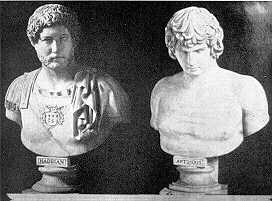
|
A famous same-sex couple in ancient Rome.
The emperor Hadrian (76-138) and his beloved favorite Antinous (110-130). When Antinous tragically drowned in the Nile, Hadrian declared him a god and had temples erected for him throughout the Roman empire.
|
There was no need for "gay liberation" in Greek and Roman antiquity. Men were
expected to marry and have children, but, apart from that, society paid little or no attention to their sexual behavior. Whether they
had male or female lovers before or during their marriage was a matter of social indifference. (This was in contrast to some Germanic
tribes further North who punished same-sex erotic behavior by death.) In ancient Greece, adult men were expected to form love
relationships with male teenagers until these themselves became adults and married. They then repeated the cycle with with new teenagers,
and so on. This custom was known as "paiderastía" (love of young males), a term which later assumed a very different,
very negative meaning. In the original, the word referred to something very honorable indeed. Several Greek city states maintained
"armies of lovers", i.e. military elite troups consisting entirely of male couples, the theory being that they would never
desert each other in battle and thus be invincible. The most famous of these troups, led by the Spartan general Leonidas, indeed fought
to the death at the hands of the invading Persians at Thermopylae. Another such army, the "sacred band" of Thebes, was defeated
and killed by Philip of Macedonia, who is said to have wept at the sight of all these fallen heroes. (Military same-sex erotic
relationships have also been reported from ancient China and from the Samurai in medieval Japan.) The most famous male couple in ancient
Greece, however, were Harmodios and Aristogeiton, who killed the last Athenian tyrant and were honored by their fellow citizens with a
public monument (a double statue) as "the founders of democracy". In ancient Rome, people had a comparable, if somewhat less
idealistic attitude toward same-sex relationships. However, there were also some famous stories of undying love. For example, the greatest
of the "soldier emperors", Hadrian (76 - 138 A.D.), mourned the untimely death of his young lover Antinous by immortalizing
him in countless statues and by building temples in his memory all over the Roman empire. Some of these statues and/or portrait busts
can still be admired today in various museums (Rome, Naples, Vatican, Athens, Olympia, Berlin, Dresden, Munich, Paris, Copenhagen a.o.)
 Same-sex Eroticism and Christianity
Same-sex Eroticism and Christianity
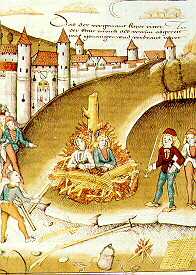
|
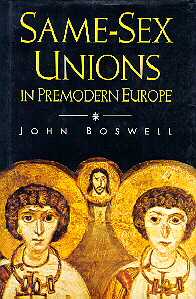
|
Death penalty for a male couple
In medieval Christian Europe, same-sex contacts were considered "abominations" and often punished by death as "sodomy". The contemporary picture shows the public burning of two male lovers in Zurich 1482.
© Zurich Central Library.
|
Study by an American historian (1994).
The book tries to demonstrate the former existence of a more tolerant Christian attitude toward homosexuality. The medieval painting on the cover shows Jesus joining the Saints Sergius and Bacchus together in holy union.
|
The ancient tolerant attitude toward same-sex relationships changed completely with the arrival and eventual political triumph of
Christianity. Once it had become the official Roman state religion, it began to do unto others what had been done to it, i.e. burning
religious offenders at the stake. In the tradition of the Old Testament, same-sex erotic activity was now seen as a religious
abomination that offended God and demanded the most drastic punishment. The East Roman emperor Justinian (reigned 527- 565 A.D.),
in his famous criminal code, made sexual contact between men a capital offense. It remained so in all Christian countries until
well into the 18th century, when the laws were gradually softened, requiring only imprisonment. Finally, fulfilling a demand of the
French Revolution of 1789, the French emperor Napleon issued a new legal code removing all religious influences from the criminal
law. Thus, among other things, same-sex erotic contact was no longer punishable in France and in those countries that came under
Napoleonic influence. This prompted wide-spread efforts to reform the law in the rest of Europe as well. These efforts, in turn,
sought support in fanciful new scientific theories that would prove the propensity for same-sex erotic contact to be an inborn
condition.
 The First "Gay Liberation Movement" (1897)
The First "Gay Liberation Movement" (1897)
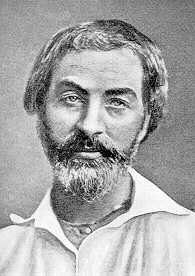
|
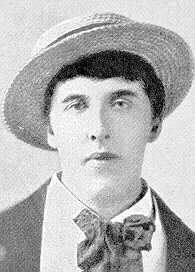
|
|
Icons of the first "Gay Movement"
|
|
The American poet Walt Whitman (1819- 92) had praised "the love of comrades" in his "Leaves of Grass". Not only the erotic content, but also the style of his poetry was revolutionary and made Whitman the prophet of an all-embracing democratic future.
|
The Irish-English writer Oscar Wilde (1854-1900) was found guilty of same-sex contacts and sentenced to two years of "hard labour" in 1895. This case inspired Hirschfeld in 1897 to found the first "gay rights" organization.
|
By the late 19th century, the USA, Britain, Austria, and Germany were the most important countries still having the old,
unreformed laws on the books. Indeed, the trial and sentencing of the famous writer Oscar Wilde in London 1895 for same-sex
contacts once more demonstrated that the political separation of church and state was far from being accomplished in some otherwise
"enlightened" modern societies. This, together with several similar cases, finally motivated the Berlin physician
Magnus Hirschfeld and some of his friends in 1897 to found the first "gay rights"
organization, the Scientific Humanitarian
Committee. This group fought for law reform not only in Germany but also in other countries and finally seemed on the brink of
success, when the new Nazi government in Berlin dashed all hopes and, in fact, destroyed Hirschfeld's
Institute for Sexology and the whole new science of sex. On the occasion of the first
" gay centennial" in 1997, Berlin offered two commemorative events: a large exhibition at the Academy of Arts, and a
scientific congress under the title "100 Years of Gay Liberation".
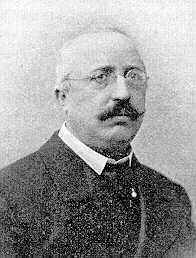
|
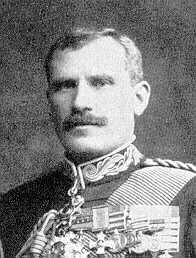
|
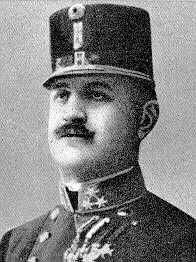
|
|
Three prominent victims of laws against homosexual behavior
|
|
The German industrialist and "cannon king" Friedrich A. Krupp committed suicide in 1902, because a newspaper had threatened to expose his homosexual contacts on the island of Capri.
|
The British general Sir Hector Macdonald committed suicide in 1903, because he faced the exposure of his homosexual contacts on the island of Ceylon.
|
The Austrian colonel Alfred Redl committed suicide in 1913, because Russian intelligence knew about his homosexual contacts and had blackmailed him to reveal military secrets.
|
 The Second "Gay Liberation Movement" (1969)
The Second "Gay Liberation Movement" (1969)
It was not until the 1960's and 1970's that the German, British, and American laws (at least in some of the 50 states of the USA)
were finally reformed. In the US, this was at least partly due to the pressure exerted on psychiatric and legal experts by a second
"gay liberation" movement, which had started in San Francisco and New York in the late 1960's. One defining moment was a
riot in 1969 that ensued when the patrons of a gay bar ("The Stonewall Inn" on Christopher Street, New York City) faught
back against a police raid. Indeed, many Americans date the beginning of the modern gay movement from "Stonewall". In
commemoration of this event, they began to celebrate its anniversary in late June as "Christopher Street Day". They
organized public parades in New York, San Francisco, and other American cities to proclaim their "gay pride". Soon, this
custom was adopted by gays and lesbians in many other countries, and today such parades can be seen in Canada, Europe, Australia,
and some Latin American countries as well. In the meantime, gays and lesbians have, on the whole, made some progress against legal
discrimination, although, in some countries, it still continues or has even become worse. An ever better organized gay/lesbian movement,
however, continues to fight for its rights, including the right to same-sex marriage. In many respects, gays and lesbians now have
diverging interests, the latter having a particular stake in the success of the women's movement. Moreover, there is now also a bisexual
movement which questions the traditional popular dichotomies. For details about this and other issues concerning gays and lesbians
today, see "Sexual Orientation" under
Other Websites in Sexology.

|
|
The "rainbow flag" was designed by Gilbert Baker in 1978 for the San Francisco Gay Freedom Day Parade. Since then, it has become a symbol of "gay liberation" that is recognized all over the world. |
page up back to services
back to services
 Note: Our directories depend on the input of interested readers. For corrections,
additions, and suggestions, please contact: HaeberleE@web.de
Note: Our directories depend on the input of interested readers. For corrections,
additions, and suggestions, please contact: HaeberleE@web.de
Same-sex Eroticism and Christianity
The First "Gay Liberation Movement" (1897)